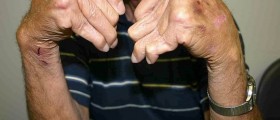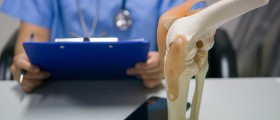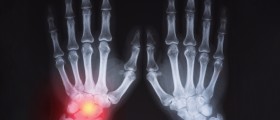Joint effusion is abnormal accumulation of the fluid inside the joints. Joints normally contain small amount of fluid. This fluid provides proper lubrication and prevents damage such as wear and tear of the end of the bones. However, a variety of conditions (most commonly inflammatory illnesses) cause excessive accumulation of the fluid inside the affected joint. The fluid originates from the the tissues which build the affected joint. Apart from inflammation joint effusion may result as a consequence of trauma. The treatment for joint effusion basically depends on the underlying cause and may be conservative or surgical.

Causes of Joint Effusion
Osteoarthritis is only one cause of joint effusion. This medical condition features with wear and tear of the cartilage that covers the ends of the bones which form the joint. Cartilage can be damaged due to over use of the joint or results as a consequence of injury or trauma. Apart from joint effusion osteoarthritis leads to acute joint pain. This medical condition predominantly affects the knee, hip, spine and feet and usually occurs in older people.
Another cause of joint effusion is rheumatoid arthritis. This inflammatory disease is accompanied by pain and also includes stiffness of the affected joints. Rheumatoid arthritis may affect people of all age including children.
Gout is a medical condition in which inflammation of the joints and accompanying symptoms occur due to accumulation of uric acid in the joints. Inflammation typically leads to accumulation of excessive fluid which results in joint effusion.
Joint effusion may be also caused by infections. A variety of bacterial, viral and fungal infections cause inflammation of joint structures and lead to excessive accumulation of the fluid in the affected joint. Pain and fever are additional symptoms of this type of infection.
And finally, sprains, fractures and other injuries of the joins typically lead to joint effusion.
Treatment for Joint Effusion
In case that joint effusion is caused by injury or osteoarthritis the doctors commonly prescribe nonsteroidal anti-inflammatory drugs. They reduce inflammation of the affected joints and lead to spontaneous withdrawal of the accumulated fluid. Another option includes corticosteroids which are also highly effective in battle against inflammation. Medications are either taken orally or administered in a form of injections.
In some cases, joint effusion may be partially alleviated by heat or cold ice packs.
Excessive fluid can be also removed with a needle. This procedure is called aspiration. In infections samples of the fluid are taken for analysis and according to the infective agents patients are prescribed specific medications.
Joint effusion caused by injuries or trauma withdraws spontaneously within certain period of time. And finally, severe trauma and damage of the joint structures requires surgical repair.
- Septic joint: Once the lab studies have been sent, start intravenous (IV) antibiotics for the suspected infective agent. The most common bacterial causes include staphylococci (40%), streptococci (28%), gram-negative bacilli (19%), mycobacteria (8 percent), gram-negative cocci (3%), gram-positive bacilli (1%), and anaerobes (1%). Also, orthopedic consult may be necessary. Drainage of the joint is associated with rapid recovery and low morbidity. Arthroscopy allows visualization of the joint, provides the ability to lyse adhesions, drains any purulent pockets, and can facilitate debridement of necrotic material if needed.
- Ligamentous injuries: The patient can be placed in a knee brace with an outpatient referral to an orthopedic surgeon.
- Fractures: These may need to be referred to a surgeon depending on severity. The Salter-Harris classification can be used for pediatric fractures involving the growth plate.
- Rheumatologic conditions: Anti-inflammatories (NSAIDs) or acetaminophen can be used, and the patient should be referred to a rheumatologist.
- For acute pain and swelling, treatment should be individualized. This includes splints, cold or ice packs, partial or non-weight-bearing braces, non-steroidal anti-inflammatories (NSAIDs), or other analgesics. If the joint has a large effusion causing pain, drainage may be an effective treatment. The fluid sample should be obtained and tested/cultured before starting antibiotics. Intra-articular steroids should be held until infection, or other contraindications have been ruled out first.




-Symptoms,-Diagnosis,-Treatment_f_280x120.jpg)












Your thoughts on this
Loading...